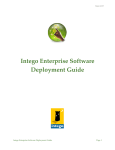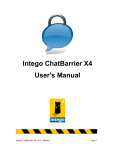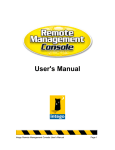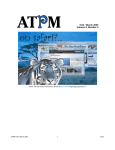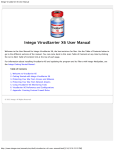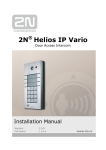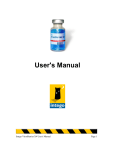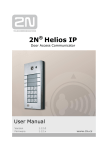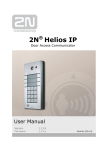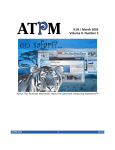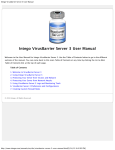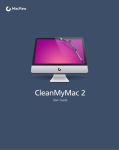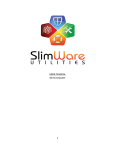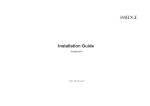Download Intego Enterprise Software Deployment Guide
Transcript
Intego Enterprise Software Deployment Guide www.intego.com Intego Enterprise Software Deployment Guide ! Page 1 Table of Contents Introduction!......................................................................................................................................3 Managing Macs in the Enterprise!.....................................................................................4 Using Remote Management Console to Manage Intego Software!..............................5 Updating Intego Software!..................................................................................................6 Deployment Architecture!..............................................................................................................7 Preparing for Deployment!.............................................................................................................8 Make an Inventory of Mac Client Computers!.................................................................8 Remove Any Existing Antivirus Software!.......................................................................8 Turn On Remote Management on Client Macs!...............................................................8 Ensure that the Required Network Ports are Open!........................................................9 Create Apple Remote Desktop Client Installers!...........................................................10 Installing Packages with Apple Remote Desktop!...................................................................11 Installing Packages from the Command Line!..........................................................................12 Using Intego Remote Management Console!............................................................................13 The Intego Answer!.........................................................................................................................14 www.intego.com Intego Enterprise Software Deployment Guide ! Page 2 1. Introduction This deployment guide examines the procedures and best practices for installing and deploying Intego software in an enterprise environment. It covers all aspects of deployment, from preparation to installation, then looks at using Intego Remote Management Console to manage any number of Macs that are running Intego VirusBarrier, ContentBarrier and/or NetUpdate. This deployment guide explains the following: • How to prepare your Macintosh computers for deploying Intego software • What preparation is needed for client computers to ensure rapid deployment • Which network ports and protocols are used for deployment and management • How to install packages with Apple Remote Desktop • How to install packages manually or via the command line • An overview of using Remote Management Console This guide will help IT managers and network administrators who are unfamiliar with Macintosh computers understand which procedures are the easiest and most efficient for installing software on many Macs at once. The scenario used in this guide will focus on installing VirusBarrier X6 client software on multiple Macs and managing them with Remote Management Console 2; the procedure is the same for other Intego programs. www.intego.com Intego Enterprise Software Deployment Guide ! Page 3 Managing Macs in the Enterprise Intego’s powerful software protects Macs on a network, and administrators responsible for large numbers of Macs need tools to easily manage these computers, apply security policies, and change and apply settings for individual Macs and groups of Macs. Remote Management Console 2 offers these features for managing Intego software on any number of Macs, from one to one hundred, from twenty to twenty thousand. Using Intego software in enterprise environments is easy and efficient. First, network administrators can easily install Intego programs on multiple Macs using Apple Remote Desktop. This allows a centralized administrator to quickly protect all the Macs they are responsible for. Intego can provide pre-serialized versions of its software for licenses of 100 seats or more, streamlining the installation process even more. Next, Remote Management Console 2 allows network administrators to manage Intego security software on multiple Macs, whether on a local network or over the Internet. Remote Management Console 2 is a multi-component program: a server component is installed on an always-on Mac, client components are installed on managed workstations, and an administration console is run on any Mac. www.intego.com Intego Enterprise Software Deployment Guide ! Page 4 Using Remote Management Console to Manage Intego Software Remote Management Console 2 is designed for administrators who manage Intego security software on multiple Macintosh computers. Remote Management Console 2 allows administrators to create and apply security policies, configure individual settings and functions, and make changes to Intego programs on all managed computers quickly and easily. Policies can applied to individual workstations or to groups, and administrators can create as many policies as they need and apply them to different groups of Macs according to their usage. Certain tasks can be performed manually or automatically, and reports can be generated.! Remote Management Console uses four components to provide this functionality: • The Remote Management Console 2 Client component is installed on managed workstations and is the bridge between the Server component and the Intego software installed on the workstation. • The Remote Management Console 2 Server component retrieves settings and logs from managed workstations and provides the workstations with updated settings. This is ideally installed on a server that is always on, so it can propagate settings, perform tasks and recover logs whenever client computers are available. • Administrators use the Remote Management Console component which allows them to interact with the Server component. The Console can interact with one or more servers, and can be installed on a server where the Remote Management Console 2 Server component is installed, or on any other Mac. This program can apply policies, carry out manual or scheduled tasks on selected workstations or groups, and it can recover reports or logs from client computers. • The optional NetUpdate Proxy component can be used to save Internet bandwidth and keep software on managed workstations up-to-date without them being directly connected to the Internet. The server retrieves settings from managed workstations and the administrator can view and change these settings over a local network, or over CANs, WANs or the Internet directly or through a VPN. Remote Management Console 2 automatically detects all computers available; the administrator can manually add IP addresses for computers outside the local subnet. Administrators can access remote Macs, record information about the Intego software they are running, and view and change security policies for these programs. They can use the same policies for multiple Macs, and create groups even across locations to easily deploy their institution's or company's security policy. www.intego.com Intego Enterprise Software Deployment Guide ! Page 5 Remote Management Console manages the following programs: • VirusBarrier X6, Intego’s malware and network protection program • ContentBarrier, Intego’s content filtering solution • NetUpdate, Intego’s tool for providing automatic updates to its software Updating Intego Software With NetUpdate, provided with all Intego software, administrators can choose whether to have client computers download and install updates directly, or whether they want to download a single copy of the update packages and have client computers access them via a NetUpdate Proxy on a local server. Remote Management Console 2 lets administrators choose which source each client computer will use for installing updates. NetUpdate settings, like those for other Intego programs, can be saved as part of a policy and applied to specific Macs or groups of workstations. Administrators can also perform updates manually, for computers that are not connected to any network. NetUpdate packages can be copied to any removable media (hard disk, CD or DVD), and applied to Intego software on any Mac, as long as the Macs being updated share the same serial number as the administrator’s workstation used to save the update packages. www.intego.com Intego Enterprise Software Deployment Guide ! Page 6 2. Deployment Architecture All Intego client software runs on Mac OS X 10.5 (Leopard) or later, on Macs using Intel or PowerPC processors 1. No special system requirements affect the installation of Intego software, or the use of Apple Remote Desktop to install this software. Installation of VirusBarrier X6 with management by Remote Management Console requires the following: • VirusBarrier X6 client software installed on each client Mac • NetUpdate software, to update VirusBarrier X6 and its virus definitions, installed on each client Mac • The Remote Management Console client component, installed on each client Mac • The Remote Management Console server component installed on a server, ideally one that is always on • The Remote Management Console administration program, installed on one or several workstations used to manage the client Macs • The optional NetUpdate Proxy component, installed on a computer that is easily accessible on the network • Apple Remote Desktop, to install packages on client Macs; client software can be installed manually, but Apple Remote Desktop allows this to be done easily on a large number of Macs Intego can provide custom pre-serialized installation packages for its software, containing the client programs, the NetUpdate software, and the Remote Management Console client module. 1 Versions of some Intego programs are available for earlier versions of Mac OS X, as well as Mac OS 9. However, Remote Management Console cannot manage these versions. www.intego.com Intego Enterprise Software Deployment Guide ! Page 7 3. Preparing for Deployment To prepare for the deployment of Intego software, in this scenario VirusBarrier X6, you should perform the following steps: Make an Inventory of Mac Client Computers First, you should make an inventory of all Mac client computers on which you will install VirusBarrier X6. Check which versions of Mac OS X they are using; VirusBarrier X6 requires Mac OS X 10.5 or later. You should ideally ensure that all client Macs have the latest updates for the version of Mac OS X that they are running, because minor OS updates include security fixes that are best corrected. You can install these updates using Apple Remote Desktop, the commandline tool softwareupdate, or the Software Update pane of System Preferences. VirusBarrier X6 is fully compatible with all minor versions of Mac OS X 10.5 and 10.6. Remove Any Existing Antivirus Software If any Mac clients have other antivirus software installed, you must uninstall this software. For information on removing these programs, check their documentation. Uninstallation is usually simple, though it may require that the Mac clients be restarted. You may be able to run the uninstallers or carry out other uninstallation procedures remotely via Apple Remote Desktop; this depends on how this task is performed. Turn On Remote Management on Client Macs To be able to install packages on client Macs using Apple Remote Desktop, you must first turn on Remote Management on the managed computers. If you have not already done this by deploying Mac OS X on client computers with preset options, administrator accounts, and settings, you must do so manually. Open the System Preferences application on the client Macs, then click the Sharing icon to open the Sharing preference pane. Check Remote Management, then, if you wish, choose which users can access these computers. Click on Options and choose which actions you wish to allow. (See the Apple Remote Desktop Administrator’s Guide for more on these privileges.) www.intego.com Intego Enterprise Software Deployment Guide ! Page 8 Ensure that the Required Network Ports are Open Apple Remote Desktop and Intego Remote Management Console require that certain network ports be open for them to communicate with client Macs. You must ensure that any firewalls protecting these computers, as well as any desktop firewalls installed on these Macs, allow traffic through these ports. The following ports must be open: Remote Management Console Protocols and Ports Function Protocol Port Connections from Remote Management Console TCP 18133 Connections from workstations TCP 18134 NetUpdate (to Intego servers) TCP 80 NetUpdate Proxy (if used) TCP 8089 Apple Remote Desktop Protocols and Ports Function Protocol Port Observe and Control TCP 5900 Reporting TCP 3283 Other Functions UDP 3283 Encrypted File Transfer TCP 22 (SSH) Note: Apple Remote Desktop pings computers on a local network to determine if they are manageable. If client computers have a firewall installed, this software may block these pings, assuming that they may be hostile. If necessary, you may need to turn off endpoint firewall protection on these Macs temporarily. If you only plan to use Apple Remote Desktop to install packages, you can change these settings back to your default after you have completed the installation procedure. If you wish to use Apple Remote Desktop after you install VirusBarrier X6, you should add the address or address range of the computer(s) running Apple Remote Desktop to VirusBarrier X6’s Trusted Addresses list, available from the program’s Antivandal pane. www.intego.com Intego Enterprise Software Deployment Guide ! Page 9 Create Apple Remote Desktop Client Installers Manually setting up your client Macs is very time-consuming, so Apple Remote Desktop offers another way to set up Macs for remote management. From the Apple Remote Desktop application, choose File > Create Client Installer. This allows you to create a custom Apple Remote Desktop Client installation package that you can then deploy on all your Macs. This allows you to create a custom administrator’s account and configure some other settings. You use an assistant to set up the client installer. You can choose whether the program’s menu bar icon should be displayed, you can create user accounts (such as an administrator’s account), and you can set all the access privileges that were mentioned above. When the assistant has completed, it saves an installer package that you then deploy manually on all the Macs you are managing. Once this is done, you will be able to install any other software packages remotely on the managed Macs. www.intego.com Intego Enterprise Software Deployment Guide ! Page 10 4. Installing Packages with Apple Remote Desktop Once your Mac clients have Remote Management activated, you can begin installing VirusBarrier X6 or other Intego software. (See the Apple Remote Desktop Administrator’s Guide for information on finding computers, creating computer lists, and other management procedures.) Simply select the computer(s) on which you wish to install Intego software, click the Install icon in the Apple Remote Desktop toolbar, and select the installation packages you wish to install. Intego can provide custom pre-serialized installation packages for its software, containing the client programs, the NetUpdate software required for automatic updates to Intego software, and the Remote Management Console client module, required for management by Intego Remote Management Console. www.intego.com Intego Enterprise Software Deployment Guide ! Page 11 5. Installing Packages from the Command Line You can also install packages from the command line, if necessary; you can do so remotely if your client Macs have Remote Login activated (in the Sharing preference pane). This allows ssh access to these computers. To install packages from the command line, do the following: • Open the Terminal application (located in /Applications/Utilities/). • Copy the installer package to the client computer by typing: $ scp -r <path to installer package> <user>@<host>:<path to package destination> For other options, see the scp man page. • Log in to the client computer by typing: $ ssh <user>@<host> For other options, see the ssh man page. • On the client computer, install the package by typing: $ sudo installer -pkg <path to package> -target / For other options, see the installer man page. www.intego.com Intego Enterprise Software Deployment Guide ! Page 12 6. Using Intego Remote Management Console Remote Management Console allows you to perform the following tasks: • Manage Intego software on multiple Macs • Organize client computers by list or group • Apply security policies by list or group • Access information about managed client Macs • Perform automatic and manual updates of Intego software and filters on client Macs • Run manual tasks, such as malware scans, on client Macs • Monitor Intego software on client Macs, and access full logs All these tasks are easy to perform from a central administration workstation, and Remote Management Console lets you manage Macs anywhere on your network or over the Internet. For more information on Remote Management Console, see the program’s User Manual. www.intego.com Intego Enterprise Software Deployment Guide ! Page 13 7. The Intego Answer This document has shown the basic steps for deploying Intego Internet security software on large numbers of Macs. Intego has broad experience with deployments of all sizes. From individual schools, with a few dozen Macs, to 1,000 seats for the BBC in the United Kingdom, to 90,000 seats for schools all across the province of Ontario, Canada, Intego has met the needs of companies, universities and school districts around the world. Intego can help you refine your deployment strategy, if necessary, and can customize its software, if you wish to change certain functions or remove access to certain software features. For more information about Intego Mac security software, visit the Intego web site, www.intego.com. www.intego.com Intego Enterprise Software Deployment Guide ! Page 14














